Adventure doesn’t have to mean far-flung travel. Sometimes the best can be on your doorstep. We regularly ride the roads around Salisbury Plain, but it’s a huge area with few roads passing across it – something to do with soldiers and health and safety. But, with the right sort of two-wheeled weaponry, we figured, it should be possible to ride a more complete circuit of the Plain and surrounds, using any available road or trail.
The route plan was loose, start at the north of the Plain and travel around in a clockwise direction for roughly 75 miles. With some waypoints in mind, the challenge would be to join them up and avoid as much tarmac as possible.
First of our three steeds was Cannondale’s Slate, which looks like the love child of a road bike and mountain bike. With its drop bar, large volume tyres and single-legged Lefty fork, it’s anything but conventional.
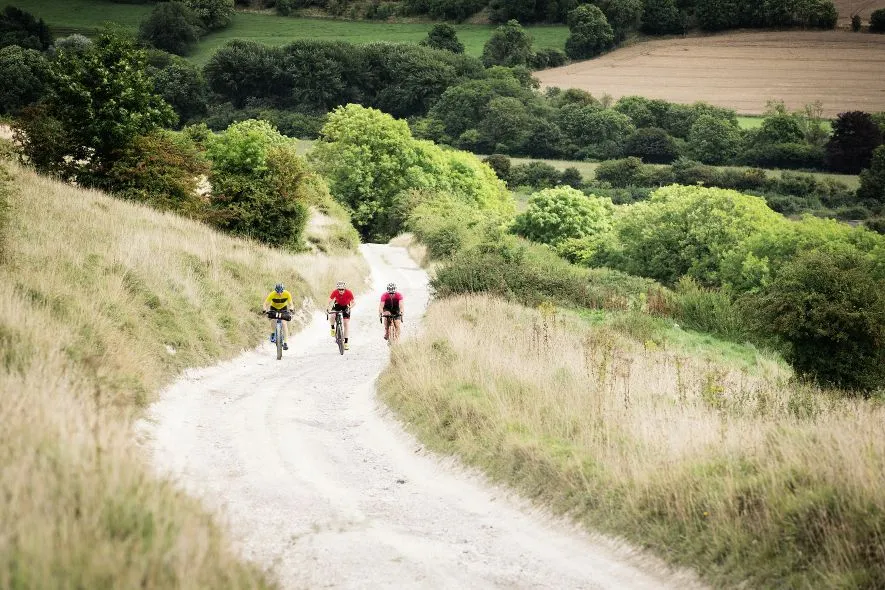
The U.P. on Open’s frameset stands for Unbeaten Path, leaving little doubt where this bike is aimed. Designed by Gerard Vroomen, one of the founders of groundbreaking Canadian carbon master Cervélo, the U.P. has caused a stir among those with a passion for high performance, go-anywhere versatility. Finally, the joker in our pack is a Jeff Jones 29 Plus. It may look like a weird mountain bike, but this spindly-looking steel frame is more nimble than other big-tyred mountain bikes, and the rigid Truss fork provides sufficient compliance and flex, and good tyre volume. Steered by the brilliant Jones H-Bar, with its pronounced curve backwards and extra length outside the brake levers for a comfortable and great handling feel, the Jones was born to explore.
Initial rides on the Slate had shown us that its standard Cannondale-branded Panaracer tyres would be very limited away from tarmac. A 55-mile club run averaging over 20mph was easily within the Slate’s road repertoire, but for greater versatility, we swapped the fragile fine file tread boots for Schwalbe’s excellent G-One 1.65in (42mm) tyres. The Slate’s recent Mavic XM419 rim upgrade also meant a simple tubeless setup with the Schwalbes for extra speed and security.
Open only sells the U.P. as a frameset. Ours already bore a couple of wounds from untold foreign jaunts, but arrived with an equally epically long HED stem and slick tyres. After a stem swap and adding Panaracer Comet Hardpack 2in wide tyres on the 650b (27.5in) HED Ardennes wheels, we just had to remember the right-hand rear braking setup.
Jeff Jones also just sells framesets to those looking for uncomplicated, rewarding riding, and ours came built with a robust Shimano spec, Hope Pro 2 Evo hubs and WTB Scraper rims, shod with massive Maxxis Chronicle 3in tyres.
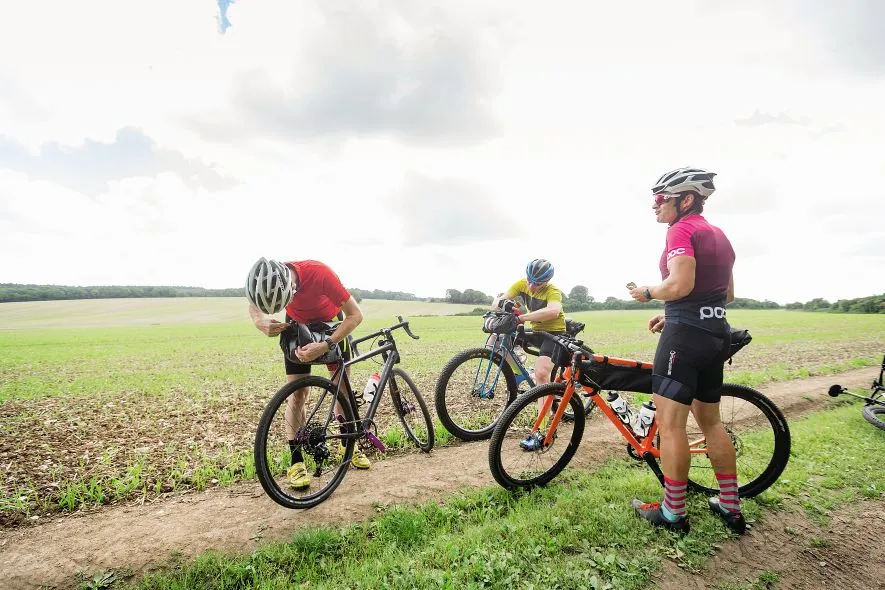
Unbeaten tracks
Early road stretches passed without drama, but did establish a tarmac speed hierarchy. With the narrowest tyres and bar, plus a zippy aluminium frame, the Cannondale regularly felt like a road bike, although a glance downwards at the Lefty fork dispelled that thought. Close behind was the Open, its low overall mass, reasonably swift wheels and drive directness keeping it snapping at the Slate’s wheels. Lagging on the longer drags was the weightiest bike, the Jones, with the highest rolling resistance.
Turning on to a gravel track, the Jones floated along, its giant tubeless tyres oblivious to the stones or potholes that drew respect from the Slate. The Open was more able to follow its big-tyred buddy, feeling as happy off-road as on, but with an overall mass advantage.
As the gravel gave way to generous singletrack and rutted farm tracks, line choice became crucial. The Cannondale demanded a little more care, but displayed scalpel-like precision and sharp reflexes when needed. With its 44cm wide bar, the Open had extra fine direction control that was well matched to its 2in tyres, but also slightly lazier steering that makes sense when loaded up for adventure. The major factor to overcome when changing direction on the Jones is the higher centripetal force generated by the 29in wheels with those big tyres on, but well-considered geometry and a stubby stem controlled by a very wide swept-back handlebar keep it far more lithe than expected.

As the singletrack became more approximate, then disappeared completely between walls of rampant brambles and a ground covering of nettles, we could no longer find the path! There was nothing for it but to dismount and force a way through. The frame bag on the Open prevented normal shouldering, so it was either heave it across both shoulders or stand it on its rear wheel and follow it through, something that the Jones was ideally suited to, as its 12.5kg mass wasn’t shoulder-friendly.
Scratched and stung, we remounted to enjoy some rolling chalky descents, and the first chance to gain some real off-road speed. The Cannondale is the only bike with any actual suspension. The Slate-specific Lefty Oliver fork has a carbon body and aluminium stanchion, and makes a useful difference on rough terrain. There’s only 30mm of travel, and it’s designed to be fairly firm, operating with no sag, effectively pushing the wheel down in to depressions rather than sucking them up. A table printed on the fork leg offers a pressure guide for the air shock, and a large red two-part knurled knob atop the leg allows fine-tuning of rebound damping, with a central green button labelled “Push To Climb”. Pressing this is simple, as it’s almost reachable with a thumb from the bar, and it substantially stiffens the fork – Cannondale doesn’t describe it as a lockout – for bob-free climbing and more conventional road manners. A blow-off valve overrides this if you take a huge hit when it’s selected. On a bumpy, stony descent, the Lefty made up for its lower tyre volume, hugely increasing control, and further helped by the tall front end.
The Jones was in its element,with the longest wheelbase, greatest wheel diameter, and under 20psi in its balloon tyres, it could just roll over obstructions that would be a major problem for a typical cyclo-cross bike. An example of mechanical simplicity, the Truss fork has no moving parts, but its slim steel tubing, with elegantly cantilevered curves is clamped at each end of the head-tube, and provides a surprising amount of compliance. There’s never any visible movement, as the tyre creates most of that, but it takes a lot of the sting out of uneven ground, while remaining rigid enough for precise steering. Unwavering stability matched to a commanding riding position with the H-Bar ensured drama-free descents.

Park life
All three bikes had single ring drivetrains, with SRAM Force 1 on the Slate and Open, and mainly Shimano XT on the Jones. The Open’s carbon Force crank had a 38 ring matched to a 10-42 cassette, while the Slate’s Cannondale Si cranks had a 44-tooth SpideRing employing SRAM’s X-Sync tooth shaping under licence, also running with a 10-42 out back. With just a 32 ring on the Jones and 11-36 cassette, we worried about spinning out.
In reality, throughout our time off-road, each bike seemed to be in its sweet spot. The tallest low gear of the Slate wasn’t a hindrance, although softer conditions might have altered things, and its highest gear wouldn’t be out of place in a road race. The Open and Jones had equally super low gears at 24”, but while the U.P. could handle the fastest road sections, and had the speed to exploit its 100” top end, the Jones was realistically limited to 79”, with the advantage of much smaller jumps between ratios, something that was occasionally an annoyance on the Slate, where flatland cadence was sometimes less than ideal.
Bursting out of the trees and along a lane brought us to the imposing lodge entrance of Longleat House. Passing the house and slogging up the considerable tarmac hill eastwards, the drag of the laden Jones was partly alleviated by the distant sight of several rhinos. Meanwhile, the other two lighter and more climb-friendly bikes gradually pulled away.

Leaving the tarmac again, we found some technical singletrack through the woods, which resulted in an impromptu burn up. The surface of soft, loose mulch and dirt with regular moist sections, irregular roots and no trail building interference made it a synapse-tingling contest. The Jones was surprisingly nimble, and its grip advantage partly made up for its comparative recalcitrance to accelerate from slow speeds, as it could carry greater corner speed. The downside to the super-comfortable swept-back H-Bar was threading its considerable width between trees.
The eager-turning Slate’s responsiveness paid dividends, and with the fork working hard, could really tuck in to corners and fire out again, its only handicap being less grip in the softest sections from the gravel tyres. At times, we wondered if the Slate would benefit from bigger rubber, but while the front isn’t limited by two fork legs, the rear end’s 42mm maximum reduces options. The Open hammered through the woods like a spooked deer, skilfully skipping between corners and railing turns. Until our only puncture of the day stopped play.
With the flat fixed, things calmed a little, and still buzzing from the woods, we pulled in to a pub for a final pit stop and to discuss each bike’s attributes. Three frame materials, three tyre sizes, three very different rides, but they’d all excelled somewhere.
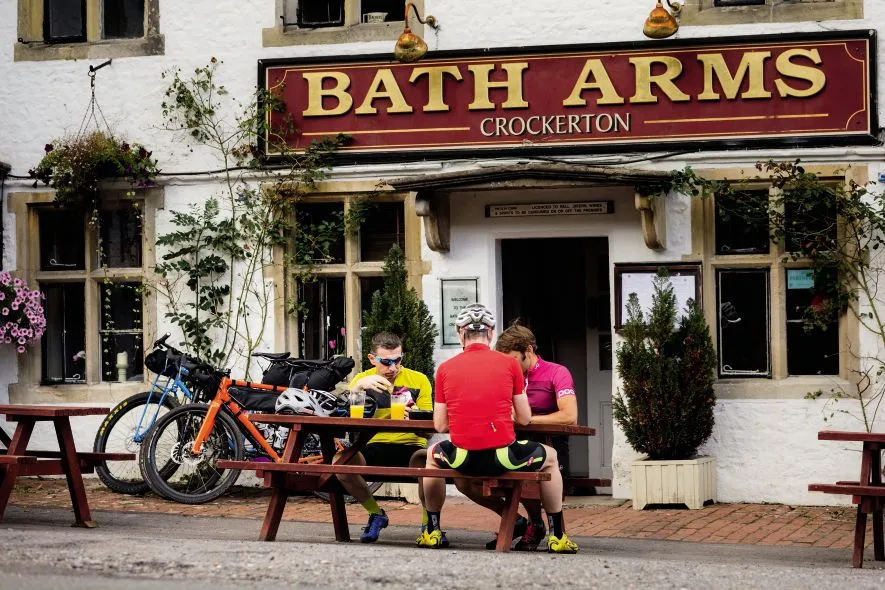
The Jeff Jones 29 Plus is a wonderful piece of engineering, and despite its size, we’d make space for one, as it never failed to put a smile on our face. It also feels somehow timeless – no matter what suspension fashions come and go, the Jones will still be there, like a faithful dog.
Cannondale’s Slate has been a bit rebellious, seemingly able to compete with road bikes on tarmac, and mince gravel and some mountain bikes on the dirt. Its quirkiness is its strength, and for the rider who likes to dabble on and off road, it could be your only bike.
If we had to choose only one, the Open has it all. It’s road bike-fast, can run 650b wheels or 700c with tyres up to 2.1in or 40mm wide respectively, is stable when loaded, but always agile, and offers excellent comfort and great tyre clearance thanks to the cleverly dropped driveside chainstay. It can be built in any specification, but we found ours very close to ideal. The U.P. opens almost every route, leaving you with no excuse for being less travelled.
OPEN U.P. £2230 (Frame, fork, headset, thru-axles)
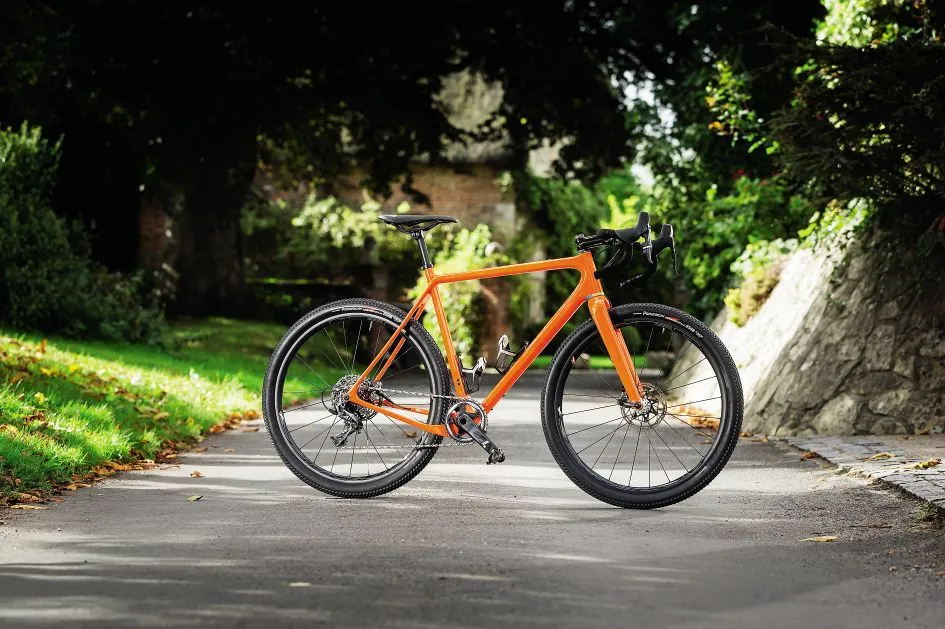
WEIGHT 8.37kg (L)
FRAME UHM and lower modulus carbon
FORK 3T Luteus II Team carbon with 15mm thru-axle
GEARS SRAM Force 1, 10-42 cassette, 38t X-Sync chainring
BRAKES SRAM Force, 160mm Centreline two-part rotors
WHEELS HED Ardennes 650b
FINISHING KIT HED Grand Tour Oversize alloy bar and stem, ENVE carbon seatpost, Fizik Tundra carbon braided saddle, Panaracer Comet Hardpack 2in tyres
HIGHS Superbly comfortable but resilient frameset, tyre options, all-round performance
LOWS Expensive to build, you’ll need to find time for more weekend epics
BUY IF You want to explore far and wide on any surface with impressive speed
CANNONDALE SLATE CX1 £3199

WEIGHT 9.09kg (L)
FRAME Slate SmartForm C1 Premium 6069 Alloy, SAVE Plus
FORK Lefty Oliver Carbon
GEARS SRAM Force CX1, Cannondale HollowGram Si crank with OPI SpideRing 44t X-Sync chainring, SRAM X1 XD Drive 10-42t cassette
BRAKES SRAM Force CX1 hydraulic disc with 160mm/140mm Centreline rotors
WHEELS Cannondale Lefty 50 front hub, Formula thru-axle rear hub, Mavic XM419 Disc rims
FINISHING KIT Cannondale C1 alloy stem, Cannondale C1 Ultralight 7050 alloy bar, Cannondale C1 alloy seatpost, Fabric Scoop Radius Race saddle, Cannondale Slate Folding TRS tubeless 650b 42mm tyres
HIGHS Unique looks, Lefty Oliver fork, purple anodising and diverse ability
LOWS Limited rear tyre clearance, gearing jumps on tarmac
BUY IF You want an entertaining bike that’s versatile and surprisingly fast everywhere
JONES PLUS £1350 (frame and fork) £3000 (as built)
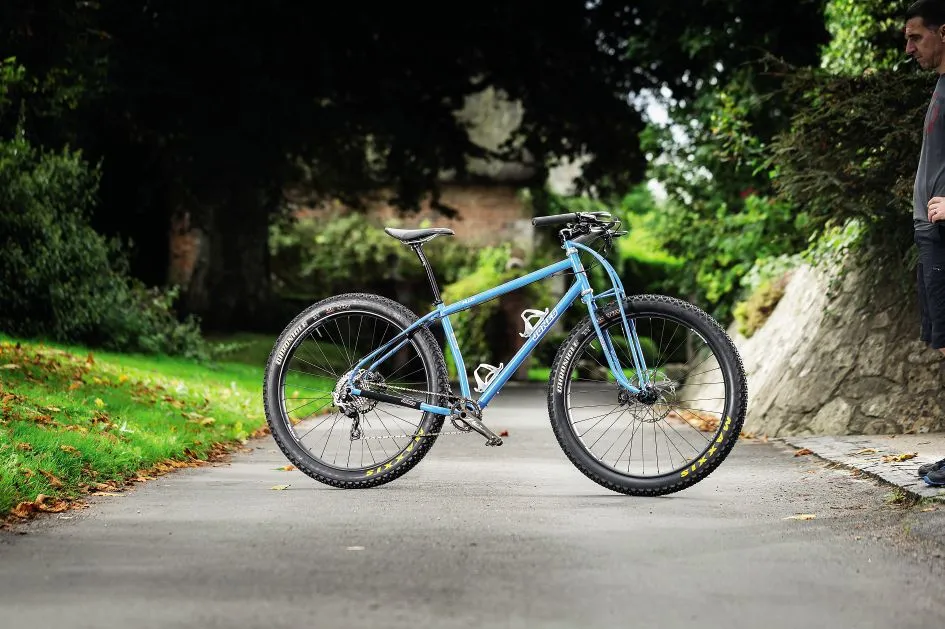
WEIGHT 12.46kg (24in)
FRAME 4130 chromoly steel
FORK 4130 chromoly steel
GEARS Shimano XT levers & rear mech, Shimano Zee crank with Race Face 32t wide/narrow chain ring, 11-36t cassette
BRAKES Shimano M785 hydraulic disc, Shimano SLX 203mm rotors
WHEELS Hope Pro 2 Evo hubs, WTB Scraper rims
FINISHING KIT Thomson X4 alloy stem, Jones carbon H-Bar, Thomson Elite alloy seatpost, Charge Spoon saddle, Maxxis Chronicle 29x3in tyres
HIGHS Innovative frame and fork, comfy H-Bar, handling confidence, ability
LOWS Weight of steel version, acceleration from slow speeds, bar width in trees
BUY IF You want a smile-inducing, go-anywhere monster bike that won’t date
Sign up to the Cycling Plus Newsletter here
We've been seeking out the best new bikes for 25 years – subscribe to find your n + 1!
